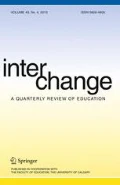Abstract
This study examines the impact of secondary school culture on the dual student outcomes of academic achievement and engagement with the institution attended. Elements of school culture were identified, specifically the roles played by administrators, the professional teaching staff, and the adolescent peer group. A mixed-method research design was employed with the primary research instrument taking the form of a survey questionnaire that was distributed to 268 Grade 11 students attending two composite secondary schools in a mid-sized Canadian city. The results demonstrated that institutional culture had a limited impact on student academic achievement but a significant influence on students' perceptions of engagement with their schools.
Similar content being viewed by others
References
Anderson, G.L. (1997). The cultural politics of schools: Implications for leadership. In K. Leithwood et al. (Eds.), International handbook of educational leadership and administration (pp. 947-966). Dordecht, NL: Kluwer.
Anisef, P. & Johnson, L. (1993). The young adult learner: Fifteen to eighteen year old stu dentsin the Ontario English language school system, Vol. 2. Toronto: Queen's Printer for Ontario.
Bowlby, J.W. & McMullen, K. (2002). At a crossroads: First results for the 18 to 20- year-old cohort of youth in transition survey. Ottawa: Her Majesty in Right of Canada.
Brantlinger, E. (1991). Low-income adolescents' perceptions of social class related peer affiliations in school. Interchange, 22(3), 9-27.
Brantlinger, E. (1993). Adolescents' interpretation of social class influence on schooling. Journal Classroom Interaction, 28(1), 1-12.
Brown, R.S. (1993). A follow-up of the grade 9 cohort of the 1987, every secondary student survey secondary student survey participants. Toronto: Toronto Board of Education.
Brown, B., & Lohr, M.J. (1987). Peer-group affiliation and adolescent self-esteem: An integration of ego-identity and symbolic-interaction theories. Journal of Personality and Social Psychology, 52(1), 47-55.
Crocker, J. & Major, B. (1989). Social stigma and self-esteem: The self-protective properties of stigma. Psychological Review, 96(4), 608-630.
Cusik, P. (1991). Student groups and school structure. In J.P. Shaver (Ed.), Handbook on research on social studies teaching and learning (pp. 276-289). New York: Macmillan.
Damico, S.B. & Roth, J. (1991). The neglected dropout: General track students. Paper presented at the annual meeting of the American Educational Research Association, Chicago, IL.
Dei, G.J. (1996). The role of Afrocentricity in the inclusive curriculum in Canadian schools. Canadian Journal of Education, 21(2), 170-186.
Delaney, B. (1991). Allocation, choice and stratification within the high school: How the sorting machine copes. Journal of Education, 99(2), 1987-207.
Finley, M.K. (1984). Teachers and tracking in a comprehensive high school. Sociology of Education, 57(4), 233-243.
Finn, J.D. (1989). Withdrawing from school. Review of Educational Research, 59(2), 117-142.
Frymier, J. (1987). Improving the quality of life in high schools. High School Journal, 70(2), 95-101.
Gaskell, J. (1995). Secondary schools in Canada: The national report of the exemplary schools project. Toronto: Canadian Education Association.
Gray, K. (1993). Why we will lose: Taylorism in America's high schools. Phi Delta Kappan, (January), 370-374.
Hargreaves, A. & Macmillan, R. (1992). Balkanized secondary schools and the malaise of modernity. Paper presented at the annual meeting of the American Educational Research Association, San Francisco, CA.
Harris, J.R. (1995). Where is the child's environment? A group socialization theory of development. Psychological Review, 102(3), 485-489.
Hemmings, A. (2000). The “hidden” corridor curriculum. High School Journal, 83(2), 1-10.
Lawton, S. & Leithwood, K. (1988). Student retention and transition in Ontario high schools: Policies, practices, prospects. Toronto: Queen's Printer for Ontario.
Lee, V., Bryk, A. & Smith, J. (1993). The organization of effective secondary schools. Review of Research in Education, 19, 171-237.
Malloy, W. (1996). Essential school and inclusion: A responsive partnership. Educational Forum, 60, 228-236.
Merriam, S.B. (1998). Qualitative research and case study application in education. San Francisco, CA: Jossey-Bass.
Meyerson, D., & Martin, J. (1998). Cultural change: An integration of three different views. In A. Harris, N. Bennett, & M. Preedy (Eds.), Organizational effectiveness and improvement in education (pp. 31-43). Buckingham: Open University Press.
Oakes, J. (1985). Keeping track; How schools structure inequality. Binghampton: Vail Ballou Press.
Page, R. (1987). Teachers' perceptions of students: A link between classrooms, school cultures and the social order. Anthropology & Education Quarterly, 18, 77-99.
Phelan, P. (1987). Compatibility of qualitative and quantitative methods: Studying child sexual abuse in America. Education and Urban Society, 20(1), 35-41.
Phelan, P., Davidson, A.L. & Cao, H.T. (1991). Students' multiple words: Negotiating the boundaries of family, peers and school cultures. Anthropology and Education Quarterly, 22(3), 224-250.
Rothstein, S.W. (1987). The ethic of coercion: Social control practices in an urban junior high school. Urban Education, 22(1), 53-72.
Schein, E. (1997). Organizational culture and leadership (2nd ed.). San Francisco: Jossey-Bass.
Smith, W.J., Kisber-Butler, L., LaRoque, L.J., Portelli, J., Shields, C.M., Sparkes, C.S., Vivert, A.B. (1998). Student engagement in learning and school life: National project report. Montreal: Office of Research on Educational Policy: McGill University.
Steele, C. (1997). A threat in the air: How stereotypes shape intellectual identity and performance. American Psychologist, 52(6), 613-629.
UNESCO. (1996). Learning: The treasure within. Report of the international commission on education for the twenty-first century. Paris: UNESCO.
Author information
Authors and Affiliations
Corresponding author
Rights and permissions
About this article
Cite this article
Brady, P. Inclusionary and Exclusionary Secondary Schools: The Effect of School Culture on Student Outcomes. Interchange 36, 295–311 (2005). https://doi.org/10.1007/s10780-005-6867-1
Published:
Issue Date:
DOI: https://doi.org/10.1007/s10780-005-6867-1




